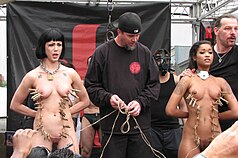
BDSM is a variety of often erotic practices or roleplaying involving bondage, discipline, dominance and submission, sadomasochism, and other related interpersonal dynamics. Given the wide range of practices, some of which may be engaged in by people who do not consider themselves to be practising BDSM, inclusion in the BDSM community or subculture often is said to depend on self-identification and shared experience.

A dominatrix, or domme, is a woman who takes the dominant role in BDSM activities. A dominatrix can be of any sexual orientation, but this does not necessarily limit the genders of her submissive partners. Dominatrices are popularly known for inflicting physical pain on their submissive subjects, but this is not done in every case. In some instances erotic humiliation is used, such as verbal humiliation or the assignment of humiliating tasks. Dominatrices also make use of other forms of servitude. Practices of domination common to many BDSM and other various sexual relationships are also prevalent. A dominatrix is typically a paid professional (pro-domme) as the term dominatrix is little-used within the non-professional BDSM scene.

Human sexual activity, human sexual practice or human sexual behaviour is the manner in which humans experience and express their sexuality. People engage in a variety of sexual acts, ranging from activities done alone to acts with another person in varying patterns of frequency, for a wide variety of reasons. Sexual activity usually results in sexual arousal and physiological changes in the aroused person, some of which are pronounced while others are more subtle. Sexual activity may also include conduct and activities which are intended to arouse the sexual interest of another or enhance the sex life of another, such as strategies to find or attract partners, or personal interactions between individuals. Sexual activity may follow sexual arousal.

Bondage, in the BDSM subculture, is the practice of consensually tying, binding, or restraining a partner for erotic, aesthetic, or somatosensory stimulation. A partner may be physically restrained in a variety of ways, including the use of rope, cuffs, bondage tape, or self-adhering bandage.

Sexual roleplay is roleplay that has a strong erotic element. It may involve two or more people who act out roles in order to bring to life a sexual fantasy and may be a form of foreplay and be sexually arousing. Many people regard sexual roleplay as a means of overcoming sexual inhibitions. It may take place in the real world, or via an internet forum, chat-room, video-game, or email—allowing for physically or virtually impossible erotic interests to be enacted.
Ageplay or age play is a form of roleplaying in which an individual acts or treats another as if they are a different age. Ageplay is roleplaying between adults, and involves consent from all parties. Ageplay is not necessarily sexual, but can be. Portraying any age can be the goal of ageplay, from babies to a child to the elderly. Usually this involves someone pretending to be younger than they actually are, but more rarely can involve assuming an older role.
In BDSM, service-oriented submission is the performance of personal tasks for a dominant partner, as part of a submissive role in a BDSM relationship. The submissive is sometimes said to be in service to the dominant. Service-oriented submission is part of a spectrum of submissive behaviors, and not all submissives are service-oriented.

Male dominance, or maledom is a BDSM practice where the dominant partner is male. A sexually dominant male in BDSM practices is also known as a maledom. A maledom who role-plays a paternal figure is also known as Daddy Dom.

Female submission or femsub is an activity or relationship in which a woman submits to the direction of a sexual partner or has her body used sexually by or for the sexual pleasure of her partner. The expression is often associated with BDSM, where submission to such activity is usually voluntarily and consensual. Submission usually involves a degree of trust by the woman in her partner. The dominant partner is usually a man, but can also be another woman, or there can be multiple dominant partners simultaneously. The submissive woman may derive sexual pleasure or emotional gratification from relinquishing control to a trusted dominant partner.

BDSM is a variety of erotic practices involving dominance and submission, roleplaying, restraint, and other interpersonal dynamics. Given the wide range of practices, some of which may be engaged in by people who do not consider themselves as practicing BDSM, inclusion in the BDSM community or subculture is usually dependent on self-identification and shared experience. Interest in BDSM can range from one-time experimentation to a lifestyle.

Erotic sexual denial is the practice of refraining from sexual experiences in order to increase erotic arousal and/or tension. It is commonly used as sex play within the context of a dominance and submission relationship, though it can also be a solo practice. The prohibited experience can be narrowly or broadly defined and banned for a specific or indeterminate length of time, depending on the practitioner. The experience withheld can be any favored or desired sexual activities, such as specific acts or positions, provided it is something the practitioner wants.

This glossary of BDSM terms defines terms commonly used in the BDSM community.

Dominance and submission is a set of behaviors, customs, and rituals involving the submission of one person to another in an erotic episode or lifestyle. It is a subset of BDSM. This form of sexual contact and pleasure has been shown to please a minority of people.
Master is an English honorific for boys and young men.

Erotic humiliation is consensual psychological humiliation performed in order to produce erotic excitement or sexual arousal. This can be for either the person(s) being humiliated and demeaned or the person(s) humiliating, or both. It is sometimes performed before spectators, including through pornography and webcam modeling. It may be part of BDSM and other sexual roleplay, or accompanied by the sexual stimulation of the genitals of one or both parties in the activity.

Consent within BDSM is when a participant gives their permission for certain acts or types of relationships. It bears much in common with the concept of informed consent and is simultaneously a personal, ethical and social issue. It is an issue that attracts much attention within BDSM, resulting in competing models of consent such as safe, sane and consensual and risk-aware consensual kink. Observers from outside the BDSM community have also commented on the issue of consent in BDSM, sometimes referring to legal consent which is a separate and largely unrelated matter. However, the presence of explicit consent within BDSM can often have implications for BDSM and the law and, depending on the country the participants are in, may make the differences between being prosecuted or not.

In human sexuality, kinkiness is the use of non-conventional sexual practices, concepts or fantasies. The term derives from the idea of a "bend" in one's sexual behaviour, to contrast such behaviour with "straight" or "vanilla" sexual mores and proclivities. It is thus a colloquial term for non-normative sexual behaviour. The term "kink" has been claimed by some who practice sexual fetishism as a term or synonym for their practices, indicating a range of sexual and sexualistic practices from playful to sexual objectification and certain paraphilias. In the 21st century the term "kink", along with expressions like BDSM, leather and fetish, has become more commonly used than the term paraphilia. Some universities also feature student organizations focused on kinks, within the context of wider LGBTQ concerns.

Animal roleplay is a form of roleplay where at least one participant plays the part of a non-human animal. As with most forms of roleplay, its uses include play and psychodrama.

The terms top, bottom, and switch are used to describe roles for the duration of a sexual act or they may more broadly denote a psychological, social, or sexual identity, or indicate one's usual preference. The terms top, bottom, and switch are also used in BDSM, with slightly different meanings. In BDSM, a top is the person doing something to someone else, and a bottom is the person receiving that act. In both contexts, the terms top and bottom refer to active and passive roles, not to who is physically on top in a particular sexual act. The older term "versatile" is sometimes used instead of "switch."
Financial domination is a fetish lifestyle activity in which a submissive is required to give gifts or money to a dominant.




















